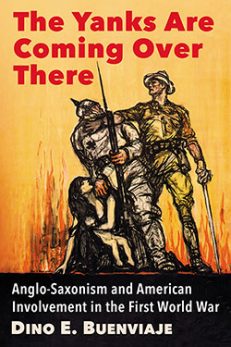The Yanks Are Coming Over There
Anglo-Saxonism and American Involvement in the First World War
$39.95
In stock
About the Book
World War I was a global cataclysm that toppled centuries-old dynasties and launched “the American century.” Yet at the outset few Americans saw any reason to get involved in yet another conflict among the crowned heads of Europe. Despite its declared neutrality, the U.S. government gradually became more sympathetic with the Allies, until President Woodrow Wilson asked Congress to declare war on Germany to “make the world safe for democracy.”
Key to this shift in policy and public opinion was the belief that the English-speaking peoples were inherently superior and fit for world leadership. Just before the war, British and American elites set aside former disputes and recognized their potential for dominating the international stage. By casting Germans as “barbarians” and spreading stories of atrocities, the Wilson administration persuaded the public—including millions of German Americans—that siding with the Allies was a just cause.
About the Author(s)
Bibliographic Details
Dino E. Buenviaje
Format: softcover (6 x 9)
Pages: 214
Bibliographic Info: 15 photos, notes, bibliography, index
Copyright Date: 2017
pISBN: 978-1-4766-6893-2
eISBN: 978-1-4766-3019-9
Imprint: McFarland
Table of Contents
Table of Contents
Acknowledgments ix
Introduction 1
The Roots of Anglo-Saxonism 7 • Anglo-Saxon Myths 8 • Bede, The Anglo-Saxon Chronicle and the Making of England 9 • Geoffrey of Monmouth’s History of British Kings and the Arthurian Legend 11 • Post-Norman England 13
Chapter I. Anglo-Saxonism and American Culture, 1895–1914 15
The Roots of American Anglo-Saxonism 15 • Late-Nineteenth–and Early Twentieth-Century Anglo-Saxonism 17 • The Anglo-American Community 28 • The White Anglo-Saxon Protestant 30
Chapter II. The German-American Connection, 1850–1914 38
Early German Migrations 39 • The Revolution of 1848 41 • German-Americans and Politics 44 • German-Americans and German Unification 46 • Germans and Anglo-Saxonism: Common Origins and Anxieties 53
Chapter III. Anglo-Saxonism in the Foreign Policy
Establishment 75
The Rise of the United States 77 • William H. Seward: The Architect of Empire 78 • Changes in American Society 80 • Alfred Thayer Mahan and the New Navy 82 • Mahan’s Influence on U.S. Foreign Policy 87 • Theodore Roosevelt 90 • The Anglo-American Rapprochement of the 1890s and its Impact on U.S. Foreign Policy 95 • The Experience of the Philippines and Anglo-Saxonism 101 • The Philippine Commissions 105 • The Boer War: A Crisis in Anglo-Saxonism and the Anglo-American Rapprochement 109
Chapter IV. Anglo-Saxonism in the First World War 118
American Neutrality 120 • William Jennings Bryan vs. Robert Lansing 129 • The Role of the American Clergy in the First World War 135 • The British and American Propaganda Machines 137 • The Anglo-American Connection 144 • Anglo-Saxonism and the First World War 148
Conclusion 171
Chapter Notes 179
Bibliography 194
Index 201






